Even as we’re zipping off to unexplored planets or strolling through the enchanted forests in our favorite novels, we sometimes get a little homesick. So in honor of Earth Day (and to celebrate the fact that it’s finally warm enough to go outside again), we’ve rounded up some ecologically-minded fiction, some based on Earth and some set beyond the stars. Join us as we journey from Jeff VanderMeer’s creepy-yet-beautiful Area X to Robert Charles Wilson’s Edenic planet Isis!
You can find all of these titles in the Tor Store on iBooks.
Annihilation—Jeff VanderMeer
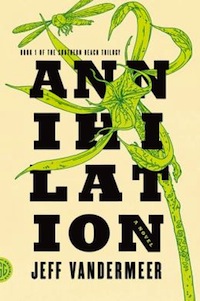
Area X has been cut off from the rest of the continent for decades. Nature has reclaimed the last vestiges of human civilization. The first expedition returned with reports of a pristine, Edenic landscape; the second expedition ended in mass suicide, the third expedition in a hail of gunfire as its members turned on one another. The members of the eleventh expedition returned as shadows of their former selves, and within weeks, all had died of cancer. In Annihilation, the first volume of Jeff VanderMeer’s Southern Reach trilogy, we join the twelfth expedition.
They arrive expecting the unexpected, and Area X delivers—they discover a massive topographic anomaly and life forms that surpass understanding. But it’s the secrets the expedition members are keeping from one another that change everything.
Arctic Rising—Tobias Buckell
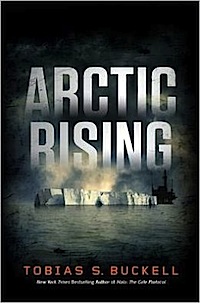
Global warming has transformed the Earth, and it’s about to get even hotter. The Arctic Ice Cap has all but melted, and the international community is racing desperately to claim the massive amounts of oil beneath the newly accessible ocean.
Enter the Gaia Corporation and its plan to roll back global warming: thousands of tiny mirrors floating in the air can create a giant sunshade, capable of redirecting heat and cooling the earth’s surface. They plan to terraform the Earth to save it from itself—but in doing so, they have created a superweapon the likes of which the world has never seen…
Slow River—Nicola Griffith
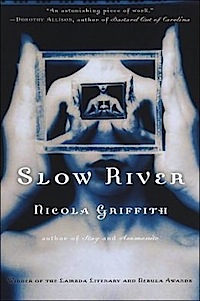 She awoke in an alley to the splash of rain. She was naked, a foot-long gash in her back was still bleeding, and her identity implant was gone. Lore Van de Oest was the daughter of one of the world’s most powerful families…and now she was nobody, and she had to hide.
She awoke in an alley to the splash of rain. She was naked, a foot-long gash in her back was still bleeding, and her identity implant was gone. Lore Van de Oest was the daughter of one of the world’s most powerful families…and now she was nobody, and she had to hide.
Then out of the rain walked Spanner, an expert data pirate who took her in, cared for her wounds, and gave her the freedom to reinvent herself again and again. No one could find Lore if she didn’t want to be found: not the police, not her family, and not the kidnappers who had left her in that alley to die. Lore begins rebuilding her life by stealing the identity implant of a dead woman to apply for an entry-level job at a eco-friendly wastewater treatment plant. As it happens, Lore knows all about wastewater treatment, which is good because things at the plant are about to go wrong…
Fuzzy Nation—John Scalzi
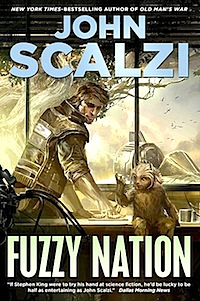
Jack Holloway works alone, for reasons he doesn’t care to talk about. Hundreds of miles from ZaraCorp’s headquarters on Earth, Jack is content as an independent contractor, prospecting and surveying the planet Zarathustra at his own pace.
ZaraCorp’s entire legal right to exploit the verdant Earth-like planet, and the wealth they derive from extracting its resources, is based on being able to certify to the authorities on Earth that Zarathustra is home to no sentient species. But when a small furry biped—trusting, appealing, and ridiculously cute—shows up at Jack’s outback home, he begins to suspect that ZaraCorp’s claim to a planet is very flimsy indeed… and that ZaraCorp may stop at nothing to eliminate the “fuzzys” before their existence becomes more widely known.
Oryx and Crake—Margaret Atwood
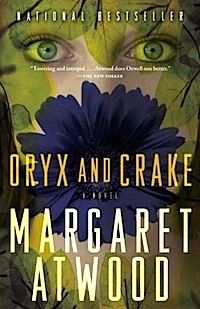
Oryx and Crake is at once an unforgettable love story and a compelling vision of the future. Snowman, known as Jimmy before mankind was overwhelmed by a plague, is struggling to survive in a world where he may be the last human, and mourning the loss of his best friend, Crake, and the beautiful and elusive Oryx whom they both loved. In search of answers, Snowman seeks the help of the green-eyed Children of Crake, and embarks on a journey through the lush wilderness that was so recently a great city.
In this first book of the Maddaddam trilogy, Margaret Atwood projects us into a near future that is both all too familiar and beyond our imagining.
Stand on Zanzibar—John Brunner
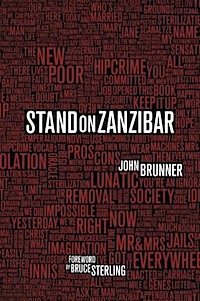
Norman Niblock House’s work is leading General Technics to the forefront of global domination, both in the marketplace and politically—it’s about to take over a country in Africa. His seemingly sheepish roommate Donald Hogan is a corporate spy, and he’s about to discover a breakthrough in genetic engineering that will change the world…and kill him.
These two men’s lives weave through one of science fiction’s most praised novels. Written in a way that echoes John Dos Passos’ U.S.A. Trilogy, Stand on Zanzibar is a cross-section of a world overpopulated by the billions. Where society is squeezed into hive-living madness by god-like mega computers, mass-marketed psychedelic drugs, and mundane uses of genetic engineering. Though written in 1968, it speaks of 2010, and is frighteningly prescient and intensely powerful.
The One-Eyed Man—L.E. Modesitt Jr.
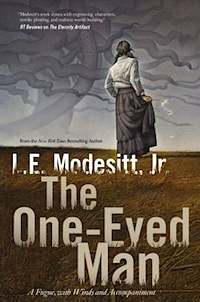
The colony world of Stittara is no ordinary planet. For the interstellar Unity of the Ceylesian Arm, Stittara is the primary source of anagathics: drugs that have more than doubled the human life span. But the ecological balance that makes anagathics possible on Stittara is fragile, and the Unity government has a vital interest in making sure the flow of longevity drugs remains uninterrupted, even if it means uprooting the human settlements.
Offered the job of assessing the ecological impact of the human presence on Stittara, freelance consultant Dr. Paulo Verano jumps at the chance to escape the ruin of his personal life. He gets far more than he bargained for: Stittara’s atmosphere is populated with skytubes—gigantic, mysterious airborne organisms that drift like clouds above the surface of the planet. Their exact nature has eluded humanity for centuries, but Verano believes his conclusions about Stittara may hinge on understanding the skytubes’ role in the planet’s ecology—if he survives the hurricane winds, distrustful settlers, and secret agendas that impede his investigation at every turn.
Shadow and Claw—Gene Wolfe
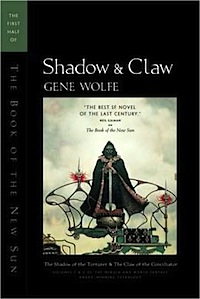
Shadow and Claw is an omnibus of the first two volumes of Gene Wolfe’s The Book of the New Sun series, The Shadow of the Torturer and The Claw of the Conciliator.
The Shadow of the Torturer is the tale of young Severian, an apprentice in the Guild of Torturers on the world called Urth, exiled for committing the ultimate sin of his profession — showing mercy toward his victim. The Claw of the Conciliator continues the saga of Severian, banished from his home, as he undertakes a mythic quest to discover the awesome power of an ancient relic, and learn the truth about his hidden destiny.
The Word for World is Forest—Ursula K. Le Guin
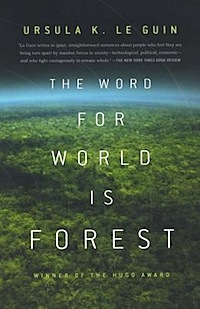
When the inhabitants of a peaceful world are conquered by the bloodthirsty yumens, their existence is irrevocably altered. Forced into servitude, the Athsheans find themselves at the mercy of their brutal masters.
Desperation causes the Athsheans, led by Selver, to retaliate against their captors, abandoning their strictures against violence. But in defending their lives, they have endangered the very foundations of their society. For every blow against the invaders is a blow to the humanity of the Athsheans. And once the killing starts, there is no turning back.
The Windup Girl—Paolo Bacigalupi
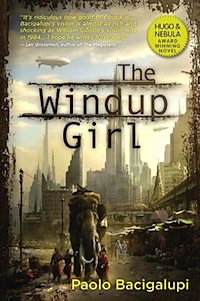
Noted short story writer Bacigalupi gives us this grim but beautifully written tale of Bangkok struggling for survival in a post-oil era of rising sea levels and out-of-control mutation.
Capt. Jaidee Rojjanasukchai of the Thai Environment Ministry fights desperately to protect his beloved nation from foreign influences. Factory manager Anderson Lake covertly searches for new and useful mutations for a hated Western agribusiness. Aging Chinese immigrant Tan Hock Seng lives by his wits while looking for one last score. And Emiko, the titular despised but impossibly seductive product of Japanese genetic engineering, works in a brothel until she accidentally triggers a civil war.
The Green Book—Jill Paton Walsh
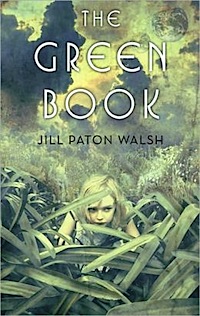
Pattie and her family are among the last refugees to flee a dying Earth in an old spaceship. And when the group finally lands on the distant planet which is to be their new home, it seems that the four-year journey has been a success.
But as they begin to settle this shiny new world, they discover that the colony is in serious jeopardy. Nothing on this planet is edible, and they may not be able to grow food. Even the excitement surrounding the hatching of the giant moth people from the “boulders” in Boulder Valley doesn’t make the group forget the hopelessness of the situation.
With supplies dwindling, Pattie and her sister decide to take the one chance that might make life possible on Shine.
Pacific Edge—Kim Stanley Robinson
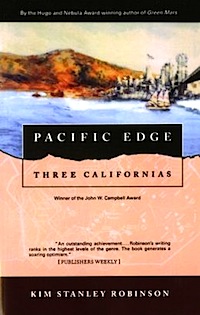
2065: In a world that has rediscovered harmony with nature, the village of El Modena, California, is an ecotopia in the making. Kevin Claiborne, a young builder who has grown up in this “green” world, now finds himself caught up in the struggle to preserve his community’s idyllic way of life from the resurgent forces of greed and exploitation.
Pacific Edge is the third novel in Kim Stanley Robinson’s Three Californias Trilogy, which also includes The Wild Shore and The Gold Coast. It was the winner of the John W. Campbell Memorial Award in 1991.
Chernobyl—Frederik Pohl

Chernobyl: The very name conjures the catastrophe that the world feared could happen someday at a nuclear power plant. On April 26, 1986, a power surge caused the core of one of the reactors to explode, spewing a cloud of radioactive steam into the Ukrainian air. More than four thousand people died, as many as a half-million suffered potentially cancer-causing exposure, and the city around the plant became a toxic wasteland in which nothing could live. Before the disaster at the Chernobyl plant, nuclear catastrophe had been only a fear, a threat. But when the Chernobyl plant was destroyed, all those fears were suddenly all too real.
Frederik Pohl’s novel of this disaster was written months after the tragic events. He had the cooperation of many people inside the U.S.S.R. with access to technical information and first-person accounts of what is still the most tragic nuclear event in human history and only one of two level 7 nuclear accidents, along with the Fukushima disaster of 2011. Despite being fiction, Chernobyl is the most riveting, realistic account of what happened that has ever been written.
The Seeds of Time—Kay Kenyon
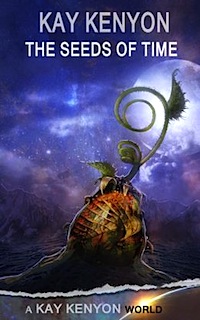
Time travel was never like this—tied to the motions of the stars, a short cut across the galaxy, and—if you’re a rare Dive pilot—a chance to be a hero. Clio Finn is a space pilot on the run from a dystopian and graying Earth toward the only future she ever wanted: the stars. Problem is, she’s on the razor’s edge of burnout, and her next stop is a labor camp in dictatorial America.
Clio might be in it for escape, for adventure, but there’s also that hero thing. Her mission: to retrieve viable biota to reseed the Earth. Now, a long way from home, she’s found the jackpot: a lush paradise, with plant life so vital, its seeds could give Earth a second chance, or—as her enemies believe—seal its destruction. But she’s determined to bring her payload home. It’s Clio Finn’s last Dive. It’s Earth’s last chance.
The Drowned World—J.G. Ballard
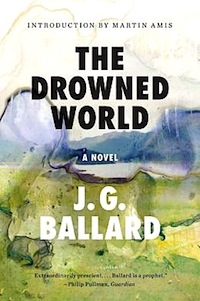
First published in 1962, J.G. Ballard’s mesmerizing and ferociously imaginative novel not only gained him widespread critical acclaim but also established his reputation as one of the finest writers of a generation.
The Drowned World imagines a terrifying world in which global warming has melted the ice caps and primordial jungles have overrun a tropical London. Set during the year 2145, this novel follows biologist Dr. Robert Kearns and his team of scientists as they confront a cityscape in which nature is on the rampage and giant lizards, dragonflies, and insects fiercely compete for domination.
Bios—Robert Charles Wilson
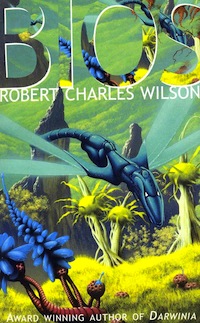
In the 22nd century, humankind has colonized the solar system. Starflight is possible but hugely expensive, so humankind’s efforts are focused on Isis, the one nearby Earthlike world. Isis is verdant, Edenic, rich with complex DNA-based plant and animal life. And every molecule of Isian life is spectacularly toxic to human beings. The entire planet is a permanent Level Four Hot Zone.
Despite that, Isis is the most interesting discovery of the millennium: a parallel biology with lessons to teach us about our own nature. It’s also the hardest of hardship posts, the loneliest place imaginable.
Zoe Fisher was born to explore Isis. Cloned and genetically engineered by a faction within the hothouse politics of Earth, Zoe is optimized to face Isis’s terrors. Now at last Zoe has arrived on Isis. But there are secrets implanted within her that not even she suspects—and the planet itself has secrets that will change our understanding of life in the universe.









